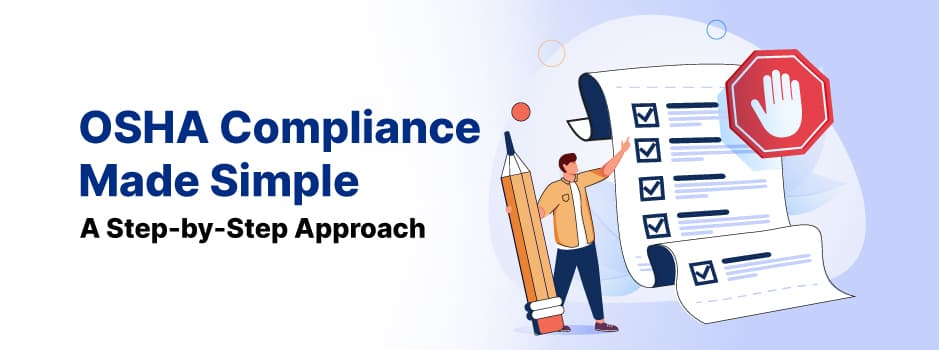Complying with Occupational Safety and Health Administration (OSHA) regulations can seem like a daunting task for many employers. However, with a clear understanding of the requirements and a step-by-step approach, achieving OSHA compliance can be made simple. This guide will provide an overview of OSHA regulations and offer a practical, step-by-step process to help employers meet their compliance obligations, ensuring a safe and healthy work environment for employees.
Understanding OSHA Regulations
The Purpose of OSHA
OSHA is a federal agency responsible for enforcing regulations that ensure safe and healthy working conditions for employees in the United States. OSHA achieves this by setting and enforcing standards, providing training and education, and conducting inspections to verify compliance.
OSHA Standards
OSHA standards are rules that describe the methods employers must use to protect their employees from hazards. These standards cover a wide range of industries, including general industry, construction, maritime, and agriculture. Employers must familiarize themselves with the specific OSHA standards that apply to their industry and workplace.
A Step-by-Step Approach to OSHA Compliance
Step 1: Appoint a Safety Officer or Safety Committee
Designate a safety officer or establish a safety committee to take responsibility for overseeing OSHA compliance efforts. This person or team should be knowledgeable about OSHA regulations and workplace processes and should have the authority to implement changes and enforce safety policies.
Step 2: Conduct a Comprehensive Hazard Assessment
Perform a thorough hazard assessment of the workplace to identify potential hazards and determine the appropriate OSHA standards that apply. This process should include:
- Regular workplace inspections
- Reviewing records of workplace injuries and illnesses
- Investigating incidents and near misses
- Soliciting input from employees regarding potential hazards
Step 3: Develop a Written Safety and Health Program
Create a comprehensive written safety and health program that outlines the company's commitment to workplace safety, hazard identification and control measures, employee training, and emergency response procedures. The program should be tailored to the specific needs of the workplace and updated regularly to reflect changes in processes, equipment, or regulations.
Step 4: Implement Control Measures
Based on the hazard assessment, implement appropriate control measures to eliminate or minimize risks. Control measures may include engineering controls (e.g., ventilation systems, machine guards), administrative controls (e.g., job rotation, standard operating procedures), or personal protective equipment (PPE).
Step 5: Train Employees on Workplace Safety
Provide comprehensive safety training for all employees, covering topics such as:
- Hazard communication and the Globally Harmonized System (GHS)
- The proper use of personal protective equipment (PPE)
- Safe work practices for specific tasks and equipment
- Emergency response and evacuation procedures
Training should be ongoing and updated as needed to address new hazards or changes in regulations.
Step 6: Establish a System for Reporting and Investigating Incidents
Create a system for employees to report workplace incidents, near misses, and safety concerns. Investigate all reports promptly and take corrective actions to prevent future occurrences. Employers should also maintain accurate records of workplace injuries and illnesses, as required by OSHA.
Step 7: Maintain OSHA Records and Documentation required to maintain various records and documentation related to OSHA compliance. This may include:
- Records of workplace injuries and illnesses (OSHA Form 300, 300A, and 301)
- Employee training records
- Hazard assessments and control measures
- Safety data sheets (SDSs) for hazardous chemicals
- Inspection and maintenance records for equipment and facilities
Ensure that all required records and documentation are up-to-date, organized, and readily accessible in case of an OSHA inspection.
Step 8: Monitor Compliance and Continuously Improve
Regularly evaluate the effectiveness of the safety and health program and make improvements as needed. This process should involve:
- Conducting periodic audits and inspections to verify compliance with OSHA regulations and internal safety policies
- Reviewing and updating the written safety and health program to reflect changes in processes, equipment, or regulations
- Soliciting feedback from employees and involving them in the continuous improvement process
Step 9: Prepare for OSHA Inspections
OSHA inspections can occur without advance notice, so it's essential to be prepared. Employers should:
- Train the safety officer or safety committee on how to handle an OSHA inspection
- Ensure all required records and documentation are readily available
- Address any identified violations promptly and maintain records of corrective actions
Conclusion
Achieving OSHA compliance may seem like a complex process, but with a systematic, step-by-step approach, employers can navigate the requirements and create a safer, healthier work environment for their employees. By understanding OSHA regulations, conducting thorough hazard assessments, implementing control measures, and maintaining proper documentation, organizations can not only achieve compliance but also reduce the risk of workplace accidents and injuries, ultimately enhancing productivity and employee satisfaction. Remember that OSHA compliance is an ongoing process that requires the commitment and active participation of everyone in the workplace.

